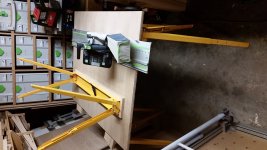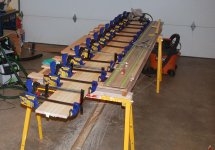I store my MFT-3 in the garage, in a folded position, vertically, in a narrow area between a wall and a cabinet. I can make a picture for you some time around this coming Thursday. I am working on a little project, so my MFT-3 is unfolded and in use, but I hope to get it back into its storage space by Thursday.
I do not use leg braces. The table is sufficiently stable without them. That small amount of wobble that it is there is not a concern.
I always remove all attachments before putting table back to storage. They take too much space (protrude over the boundaries of the table) and are easy to damage. I put them back into the box in which they arrive. The box goes into space between legs, it all fits nicely.
It is impossible to cut full sheets of plywood on this table. As it was correctly written by one of the FOG members in his answer, you either need two of these tables or a home-made assembly table. Without attachments, you can cut a sheet of about half of the standard plywood sheet - i.e., if the store where you bought it cuts it for you with their panel saw to two pieces 4 ft by 4ft in size, you can cut these pieces as you need on top of MFT-3, provided none of the attachments is installed. With attachments (fence and rail) in place, the maximum workable width of a piece which you can cut decreases to roughly 2 ft wide, if not less. It is a nice work table, but only for small pieces. It is too small even for building kitchen cabinets, if you ever thought about it.
Festool, apparently, bases its design not on criteria of usability in a shop, but on ease of transport. The idea is that a professional can put it in his van and then grab with one hand and carry to the job site. It makes it perfect to store in a small space in the garage, too, but the downside is that it is too small for about half of the tasks that you can think of.
Another downside is that the parts which you called "attachments" are designed for working with plywood with thickness of 12 mm or more. 12 mm is the thickness of what I call "fence", the aluminum rail that runs along the back of the table, which forms 90 degree angle with the guide rail. The consequence is that if your material is thinner (for instance, 15/32" plywood which we call "half inch" and which in reality is around 11 mm thick) is not held in place firmly by the rail and can slide during routing or cutting. There are simple workarounds for it (like putting a layer of thin sacrificial plywood underneath your work piece), but it is still an inconvenience. This will not be an issue if you are in Europe and all you have is 12 mm, but here in the US it can be an issue.
Don't hesitate to ask if you want me to post a couple of pictures - it is a convenient opportunity to make them.


